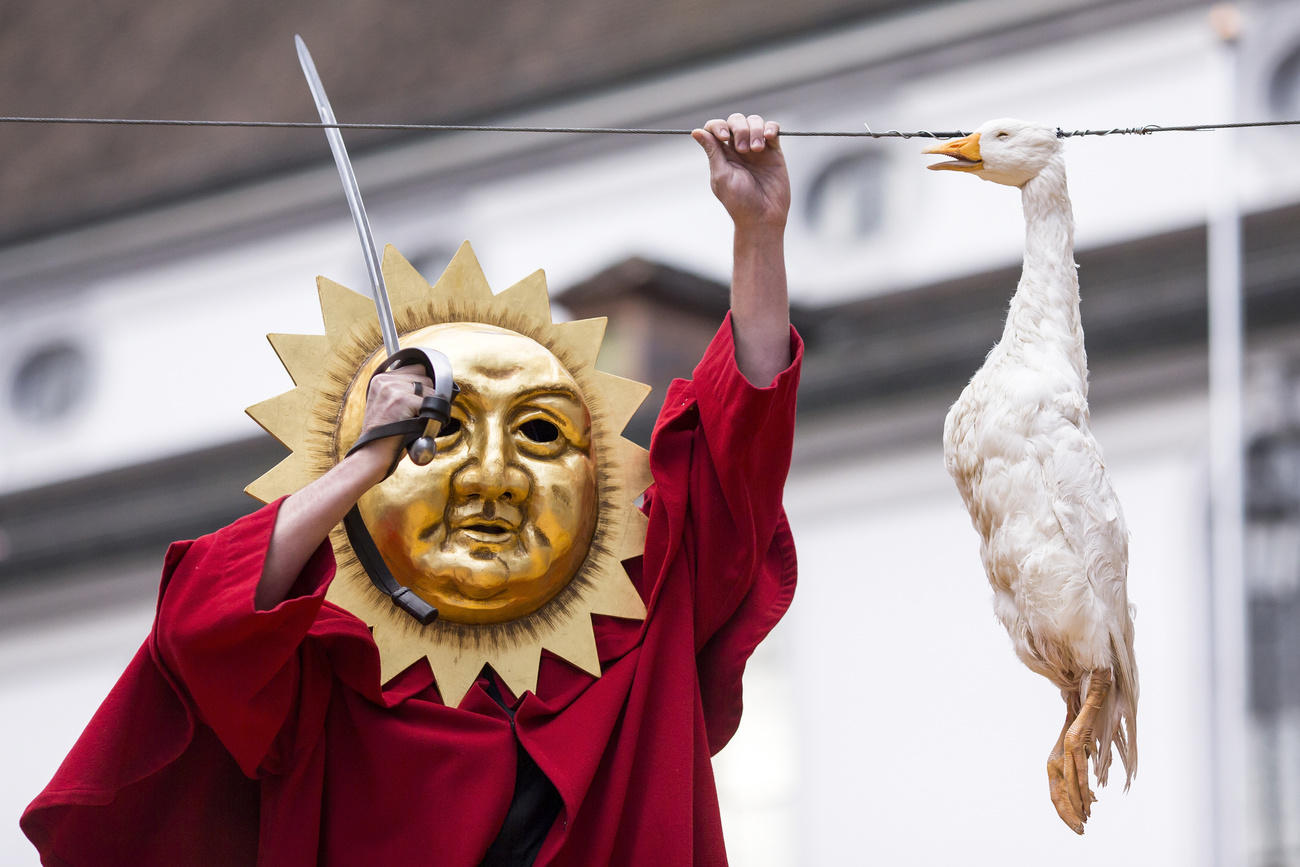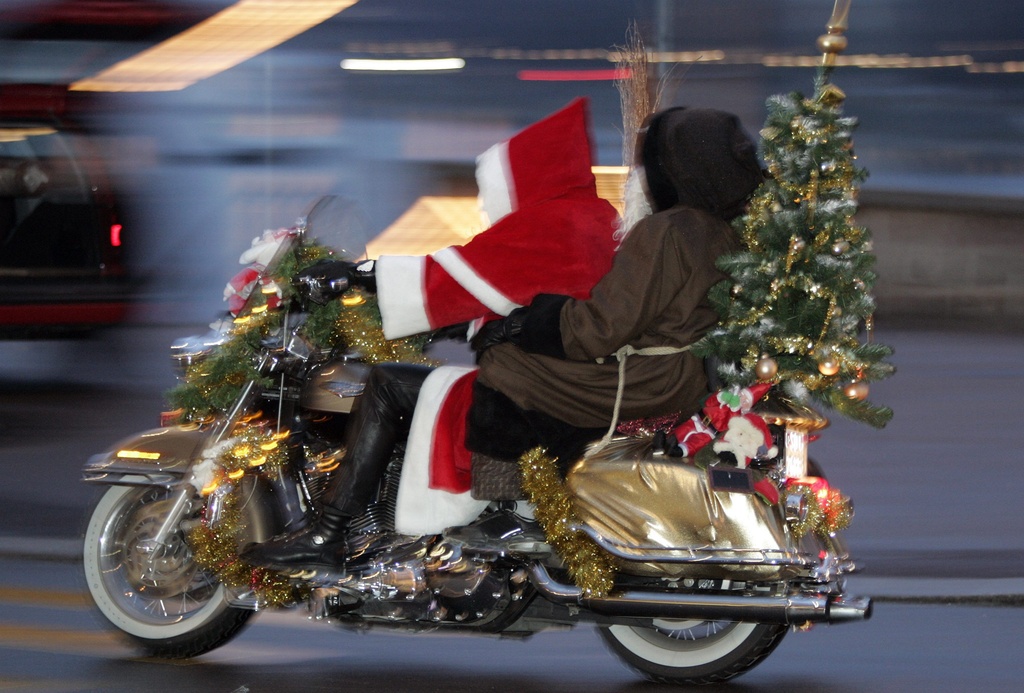
How Swiss festive bad boy Schmutzli cleaned up his act

Once upon a time, a mysterious dark-faced figure would enter Swiss homes at the beginning of December, beating and (briefly) abducting children into behaving better. Then lo, the times did change, and Schmutzli, St Nicholas’s Swiss helper, got an image makeover. What happened?
Edy Jauch still remembers seeing Schmutzli taking children into the forest in a sack. “Today, that would border on kidnapping,” he admits.
But Jauch, a member of a guild in central Switzerland that promotes traditional customs, told the Luzerner ZeitungExternal link that the guild hadn’t got rid of Schmutzli. “Schmutzli isn’t an evil, beefy bodyguard. He’s more of an assistant who stands in the background and steps forward at Samichlaus’s request. He can inspire respect, but Schmutzli shouldn’t instil fear.” It’s true that occasionally families prefer him to stay outside – “but that’s very rarely the case”.
Saint Nicholas – Saint Nicholas of Myra was an early Christian bishop born in what is now Turkey in AD270. He is the patron saint of many people, including children, sailors and brewers. Nicholas, who is usually depicted as an elderly man with a short, white, fluffy beard, had a reputation for secret gift-giving, such as putting coins in shoes left out for him. This practice is still celebrated on his feast day, December 6, the day on which he died in AD343.
Sinterklaas – Sinterklaas is a Dutch version of Saint Nicholas and is depicted as an elderly man with a long, full, white beard, wearing red bishop’s attire. His feast started in the Middle Ages, but the modern version goes back to the mid-19th century. Sinterklaas carries a big, red book which traditionally records whether each child has been good or naughty in the past year. He is assisted by Zwarte Piet (Black Pete), who wears Moorish clothes and blackface. Every year in mid-November Sinterklaas and Zwarte Piet “arrive” by boat from Spain and in the build-up to December 6 Sinterklaas parades through the streets on a white horse, while multiple Zwarte Piets throw treats into the crowd. The main gift-giving day is December 5 in the Netherlands and December 6 in neighbouring countries.
Santa Claus – Dutch settlers took the Sinterklaas tradition across the Atlantic, celebrating the feast in the colony of New Amsterdam (now New York). Sinterklaas was later anglicised to Santa Claus. His image (largely created by US artist Thomas Nast) of a portly, jolly, white-bearded old man, often with spectacles, wearing a red coat with white fur collar and cuffs, shares many similarities with the English figure of Father Christmas, and they are now regarded as the same person. Like Father Christmas, Santa Claus is helped by elves. The shifting of gift-giving from December 5/6 to December 24/25 is down to Martin Luther (see Christkind below). It’s an urban legend that Santa Claus was invented by the Coca-Cola Company.
Father Christmas – Father Christmas is the traditional English name for the personification of Christmas. He first appeared in the mid-17th century but, in his modern form, in the late 19th century. Until Victorian times, Father Christmas was concerned with adult feasting and merry-making; he had no particular connection with children, nor with the giving of presents, nighttime visits, stockings, chimneys or reindeer. But as later Victorian Christmases developed into child-centric family festivals, Father Christmas became a bringer of presents. The American myth of Santa Claus arrived in England in the 1850s and Father Christmas started to take on Santa’s attributes. By the 1880s the new customs had become established, with the nocturnal visitor often illustrated wearing a long red hooded gown trimmed with white fur.
Samichlaus – Samichlaus is the name for Saint Nicholas in German-speaking Switzerland. He is assisted by Schmutzli, who sometimes wears black make-up which represents dirt or soot.
Christkind – The Christkind or Christkindl (Christ Child in German) is the traditional Christmas gift-bringer in Switzerland, Austria, parts of Germany and several other Catholic countries in Europe and South America which adopted the custom in the 19th century. As part of the Protestant Reformation in the 16th century, Martin Luther considered praying to saints as idol worship and wanted the focus to return to Christ, making the blond-haired, angelic infant the main giver of presents. The date of giving presents shifted from December 5/6 to December 24/25.

The tradition of a bearded, slightly sinister companion for St Nicholas goes back centuries across northern Europe. In Germany, for example, the man in red is accompanied by Knecht Ruprecht (Farmhand Ruprecht) and in the Netherlands by Zwarte Piet (Black Pete, more on him later).
In Switzerland, the St Nicholas custom became interwoven with a festival of noise and masks dating back to pre-Christian times, Kurt Lussi, an author and formerly curator of religious folklore at Lucerne’s History Museum, told SWI swissinfo.ch in a previous article.
Schmutzli – Schmutz means dirt in German – was a symbol of the evil spirits which these ancient festivals sought to drive out with a combination of noise and light, he said.
This video explains the evolution of Schmutzli:
“From 1910 we have documented evidence of a strange figure who appears on St Nicholas Day and is called Butzli, which was later changed to Schmutzli,” Lussi said. “Schmutzli means an ugly character with a concealed face, and this figure appeared with a black face, red eyes and a black cap.”
Lussi cited an illustration from 1486 that depicts a demon who abducts children. “This child-stealing motif returns again in Schmutzli,” he said. “There’s also the Sträggele, another child-stealing figure which I would call a native Swiss demon. Birch brooms are associated with it and that’s also what Schmutzli carries.”

Samichlaus, the Swiss-German version of St Nicholas, and Schmutzli (known as Père Fouettard, Father Whipper, in French-speaking Switzerland) traditionally parade through the streets, visit homes and – in a classic good-cop-bad-cop double-act – find out how well children had behaved over the past year. Punishments used to include being hit (lightly) by a birch broom and being bundled into a sack or basket.
Unsurprisingly, children learnt to be somewhat wary of Schmutzli. “As children, we behaved so badly during the year that we always carried a pair of scissors in our trousers on the day Samichlaus and Schmutzli visited! We hoped to be able to cut ourselves out of the sack!” admitted a SWI swissinfo.ch colleague, who is now generally very well behaved.
“Even today kids occasionally ask whether they’re going to be abducted,” sighed Daniel Küng, president of the St Nicholas society in Littau. “We then have a few stern words with the grandfather who told them those stories,” he told the Luzerner ZeitungExternal link. “We want to get people in the mood for Christmas – we’re not the police keeping order in people’s homes.”

Last December around 50 people gathered for the Samichlaus synod in Wislikofen, northern Switzerland. If there’s one thing everyone could agree on, it’s that Samichlaus and especially Schmutzli had changed considerably over the past 25 or 50 years.
“The evil Schmutzli who puts children into a sack no longer exists,” Jürg Thrier, who had been a Samichlaus for 33 years, told the Tages-AnzeigerExternal link.
Edy Jauch said that at the Samichlaus parade nowadays there are sometimes young people who don’t understand the tradition and confront Schmutzli aggressively. “They want to take away his broom so they can beat him themselves.” The Schmutzlis are instructed not to react provocatively in such situations, he said. “Sometimes there’s an affectionate pat with the broom for a passer-by or a ‘Brämi’ for a ‘Modi’,” Jauch says with a grin. This is Schmutzli’s attempt to smear some of his own make-up on a woman’s cheek. “It’s certainly possible that that a Schmutzli ends up with practically no make-up on.”

More
They do what? Five frankly bizarre Swiss traditions
And here we have to start walking carefully through a politically correct minefield. At first glance, men in blackface forcing themselves on women could appear problematic.
In the Netherlands, Zwarte Piet, originally portrayed as a Moor, ended up at the United NationsExternal link accused of being racist and demeaning and obviously a black servant or slave from the days of Dutch imperialism.
Schmutzli, however, is very different: his dark face is due to dirt or soot. “We don’t see any problems with this tradition,” Stephanie Graetz, director of the Foundation against Racism and Anti-Semitism, told 20MinutenExternal link. She said the black-coloured Schmutzli had no racist background and emphasised the mythological origin of Schmutzli and his origins as a devilish figure.

Markus Kolly, a Samichlaus in Fribourg, has a more practical reason for the black make-up. “The point is that you don’t recognise the person behind the Schmutzli,” he told 20Minuten. “The children shouldn’t see any similarities with people they know. That’s why the Schmutzlis are given wigs and a fake beard.”
What’s more, not all Schmutzlis have dirty faces – getting make-up out of clothes is hard work, after all. Martin Kempf, who runs chlaus.ch, told 20Minuten that interpretations of Schmutzli basically differ from municipality to municipality.
“In some regions Schmutzli appears as a charcoal burner and paints people’s faces with his colour,” he said. But he also knew the opposite from his childhood. “In places in central Switzerland, Samichlaus is accompanied by helpers who are depicted in white or as angels.”

‘Samichlaus is here!’
So what do a 21st-century Schmutzli and Samichlaus actually do? Last year a journalist from the Zürichsee Zeitung spent an evening dressed as Schmutzli (pictured) accompanying Samichlaus on his roundsExternal link in Stäfa, a municipality overlooking Lake Zurich. We join them outside the first of four homes:
“Schmutzli, does my beard look all right?” he asks. I check his snow-white hair in the light of my lantern and nod. “Then you can ring the bell.” While we’re still standing in the stairwell, a child’s voice cries out: “Mummy, Samichlaus is here!” Samichlaus knocks forcefully on the front door three times and then enters.
We’re greeted by five-year-old Noé (all names have been changed), who leads us into the living room, visibly excited and with gleaming eyes. Meanwhile, his one-year-old sister Sarah looks at us in astonishment. We take a seat on the two chairs provided and Samichlaus opens his book.
“So, dear Noé,” he begins in a slightly more booming voice than before. “Have you been a good boy this year?” The child nods eagerly. “Then let’s see what Schmutzli has written about you,” he continues, giving me a conspiratorial sideways glance.
“You’re doing well in kindergarten,” Santa praises. “But at the dinner table at home you’re sometimes a bit picky.” The boy lowers his head understandingly. “That will definitely change next year,” he says.
After Samichlaus has snapped the book shut and Noé has said his piece, it’s over to me. I reach deep into my burlap sack and pull out the two small bags [filled with chocolate, peanuts and mandarins], which I hand over to the boy. “But now we’ve got to get going,” says Samichlaus, standing up and picking up his crozier. “Lots of other children are waiting for us.”
Edited by Samuel Jaberg/sb

More
‘Direct democracy hasn’t reached the North Pole’

More
Ding Dong Merrily on Heidi
More

In compliance with the JTI standards
More: SWI swissinfo.ch certified by the Journalism Trust Initiative
















![The four-metre-long painting "Sonntag der Bergbauern" [Sunday of the Mountain Farmers, 1923-24/26] had to be removed by a crane from the German Chancellery in Berlin for the exhibition in Bern.](https://www.swissinfo.ch/content/wp-content/uploads/sites/13/2025/12/01_Pressebild_KirchnerxKirchner.jpg?ver=cb688ed5)
















You can find an overview of ongoing debates with our journalists here . Please join us!
If you want to start a conversation about a topic raised in this article or want to report factual errors, email us at english@swissinfo.ch.